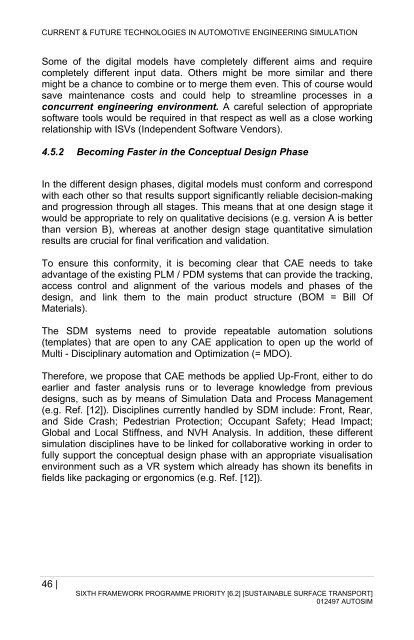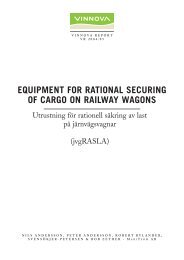Download - Autosim Autosim
Download - Autosim Autosim
Download - Autosim Autosim
You also want an ePaper? Increase the reach of your titles
YUMPU automatically turns print PDFs into web optimized ePapers that Google loves.
CURRENT & FUTURE TECHNOLOGIES IN AUTOMOTIVE ENGINEERING SIMULATION<br />
Some of the digital models have completely different aims and require<br />
completely different input data. Others might be more similar and there<br />
might be a chance to combine or to merge them even. This of course would<br />
save maintenance costs and could help to streamline processes in a<br />
concurrent engineering environment. A careful selection of appropriate<br />
software tools would be required in that respect as well as a close working<br />
relationship with ISVs (Independent Software Vendors).<br />
4.5.2 Becoming Faster in the Conceptual Design Phase<br />
In the different design phases, digital models must conform and correspond<br />
with each other so that results support significantly reliable decision-making<br />
and progression through all stages. This means that at one design stage it<br />
would be appropriate to rely on qualitative decisions (e.g. version A is better<br />
than version B), whereas at another design stage quantitative simulation<br />
results are crucial for final verification and validation.<br />
To ensure this conformity, it is becoming clear that CAE needs to take<br />
advantage of the existing PLM / PDM systems that can provide the tracking,<br />
access control and alignment of the various models and phases of the<br />
design, and link them to the main product structure (BOM = Bill Of<br />
Materials).<br />
The SDM systems need to provide repeatable automation solutions<br />
(templates) that are open to any CAE application to open up the world of<br />
Multi - Disciplinary automation and Optimization (= MDO).<br />
Therefore, we propose that CAE methods be applied Up-Front, either to do<br />
earlier and faster analysis runs or to leverage knowledge from previous<br />
designs, such as by means of Simulation Data and Process Management<br />
(e.g. Ref. [12]). Disciplines currently handled by SDM include: Front, Rear,<br />
and Side Crash; Pedestrian Protection; Occupant Safety; Head Impact;<br />
Global and Local Stiffness, and NVH Analysis. In addition, these different<br />
simulation disciplines have to be linked for collaborative working in order to<br />
fully support the conceptual design phase with an appropriate visualisation<br />
environment such as a VR system which already has shown its benefits in<br />
fields like packaging or ergonomics (e.g. Ref. [12]).<br />
46 |<br />
SIXTH FRAMEWORK PROGRAMME PRIORITY [6.2] [SUSTAINABLE SURFACE TRANSPORT]<br />
012497 AUTOSIM
















